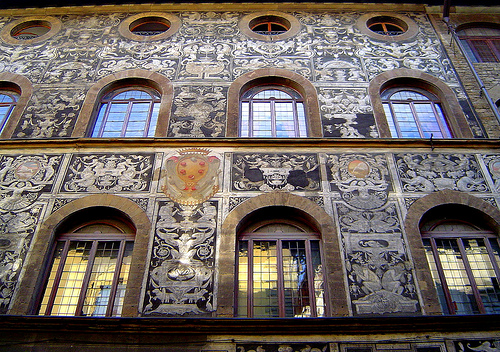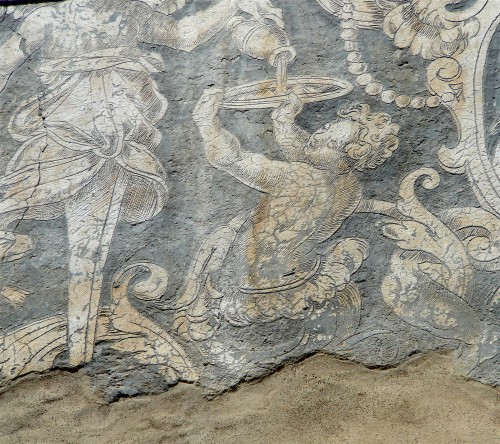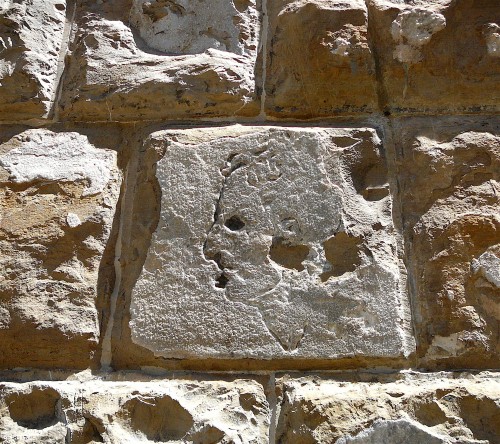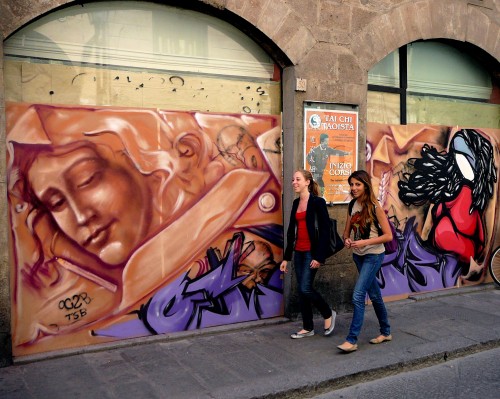Graffiti is known worldwide, but word itself has nothing to do with scrawls on walls. In Italy, the words sgraffito and sgraffiti come from the Italian word sgraffiare (“to scratch”), ultimately from the Greek γράφειν (gráphein), meaning “to write”.
Graffiti, the bane of all modern cities in the form of spray paint, in its original sense refers to marks scratched onto a surface with a tapered point. The graffito technique has been used since prehistoric times. Decades ago, my father showed me graffito animals, birds and people carved on the tufa cave walls in northern New Mexico. But in Florence, starting in the 1400s, it was a technique of wall design, where the top layer of pigment or colored plaster is scratched through to reveal an underlying layer.

“The historian and artist Giorgio Vasari recorded the graffito technique step by step. First, one paints the wall of a palazzo with a layer of lime plaster, coloured with burnt herbs or other dark pigments. Once the first layer is dry, another is painted on, this time of white plaster, distributed uniformly. On top of this second layer are laid punched-out designs, or stencils, which are reproduced on the wall with powdered charcoal (referred to as tecnica dello spolvero in Italian). A tapered awl is then used to trace the resulting pattern on the wall, cutting through the layer of white plaster to reveal the darker, underlying layer. Thus, by using the same colours as a palazzo’s frescos, the graffito designs could be used to add shadow and depth to the overall decoration.” (FirenzeTurismo.it)

My favorite examples of historic graffiti in Florence were created during the second half of the 16th century, when the graffito technique was used to design Mannerist allegories incorporating grotesque (meaning in the style of the “grotto”) designs and figures. These are still partially visible on the façade of the Palazzo Ramirez de Montalvo in Borgo degli Albizi and fully realized on the House of Bianca Cappello (grotesque sgraffito decoration by Bernardino Poccetti, 1566) on Via Maggio.
When using the term graffiti to mean defacing buildings, Michelangelo has the dubious pleasure of allegedly being one of the first famous graffiti artists – not with paint, but in the caveman version of scratching a design with a sharp point. On the corner of the Palazzo Vecchio, the one nearest to the Uffizi Gallery, any visitor to Florence can find a carving of a man’s face.

There is more than one version of the story, but the artistry is attributed only to Michelangelo. One version states that ever willing to take a dare, and supremely confident, Michelangelo turned his back, carving free-hand without looking, into the pietra serena of the city hall’s wall, he etched his own profile into the stone. Another variation has it that he carved blindly the likeness of a personal foe, so that Florentines would never forget the man’s face.

Last week, a one-day comics festival, OPEN YOUR EYES TO Comics DAY, came to Florence. Via del Corso was decorated with four modern graffiti wall decorations – sanctioned by the mayor. These were not scratched into walls, but painted on to wallboard. They won’t last 400 years, but they are better than the scourge that defiles most of Florence’s walls.
To be continued …
